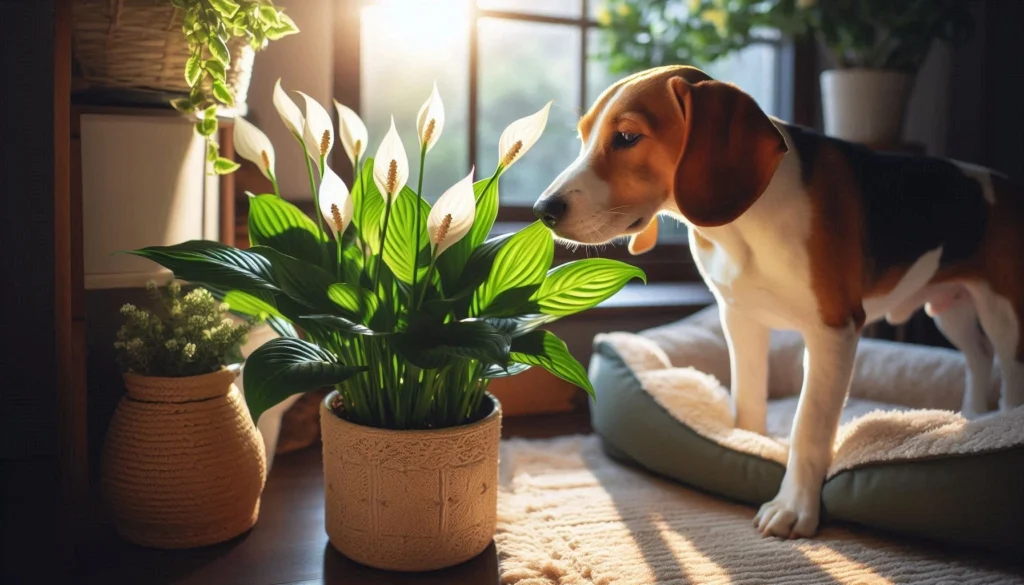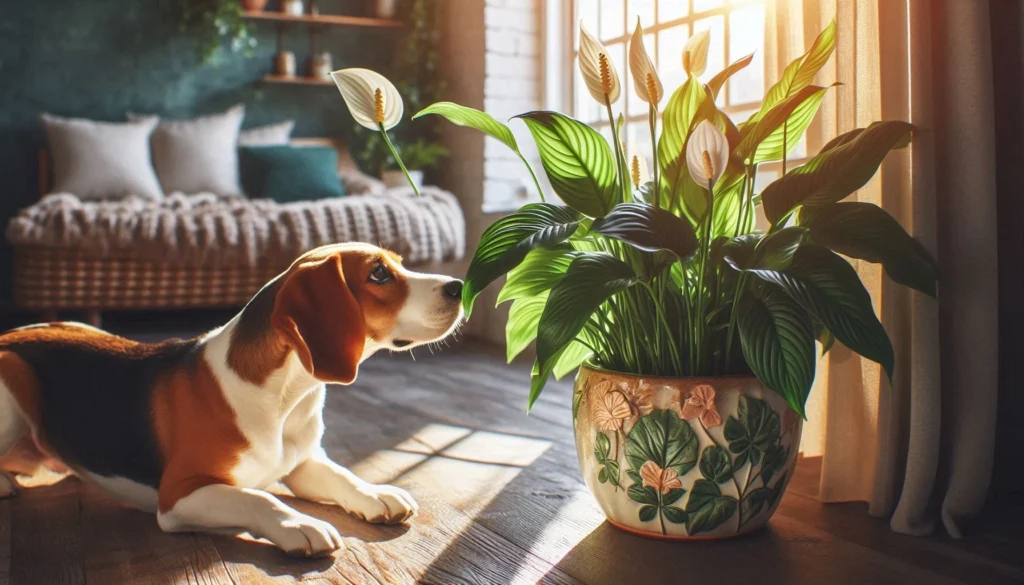The peace lily is the most popular indoor plant for its beauty and low maintenance. However, for owners of pets, especially with dogs, it is very important that they know peace lilies are toxic to dogs once ingested. The peace lily contains calcium oxalate crystals. If a pet ingests it, irritation and drooling, vomiting, and even difficulty swallowing can occur. Knowing what to look for can help prevent major issues and get help when a dog has been exposed to the plant.
It becomes necessary to react immediately when suspecting that a dog might have ingested a peace lily or chewed on it. Rinse your dog’s mouth using water with the hope that this reduces irritation, pay attention for signs of discomfort or worsened symptoms and call the veterinarian immediately.
The best way, however, in dog-friendly homes is prevention of exposure by keeping plants inaccessible to your furry friend. Most plants like peace lilies should be grown in areas difficult for easy access by dogs, can be placed higher or grow in restricted spaces, while alternatives such as dog-friendly plants, which include plants like spider plants or Boston ferns, can easily replace them, and training dogs not to touch plants as well.
If you cannot afford to lose your peace lily, install barriers or transfer the plant to a room where your dog cannot reach it. This way, despite having to take extra measures, you can enjoy your houseplants and not lose the beautiful greenery of an indoor garden at the cost of your pet’s comfort.
Key Takeaways: Peace lilies are excellent decorative pieces, but they pose potential risks for dogs. Knowing the symptoms, preventing access, and knowing when to act are all key steps to creating a safe, pet-friendly environment.
What is a Peace Lily?
Peace lilies are popular, elegant houseplants that brighten indoor spaces. They are known for their dark green leaves and stunning white flowers, which add a touch of natural beauty to any room. These plants thrive in indirect sunlight and are not demanding, making them perfect for home and office use. Scientifically known as Spathiphyllum, peace lilies are not true lilies but belong to the Araceae family.
Besides their beauty, peace lilies purify the indoor air, filtering out all sorts of toxins – ammonia and formaldehyde, just to mention a few. However, remember that peace lilies do contain calcium oxalate crystals that will harm if consumed. Broken down, these crystals will cause an irritation that’s irritating to both human and animal mucous membranes. Although adults will not attempt to chew on a peace lily, pets and smaller children may find it to be tempting or are curious about its taste or feel.
Given this risk, pet owners with peace lilies must pay attention to where the plant is situated in the house. Although the plant itself does not cause death, the substance in the plant is toxic and has enough poison to bother and even seriously disturb domesticated pets, especially canines, if ingested. Simple precautions will mean an ability to enjoy this pretty peace lily at ease, without putting furry members at risk. For pet owners, finding pet-friendly alternatives to these plants or even making a physical wall between peace lilies can be the ideal solution if you want to reap all the benefits of this ornamental plant with no problem.

Are Peace Lilies Toxic to Dogs?
Yes, peace lilies are toxic to dogs if ingested. The plant contains calcium oxalate crystals, which are needle-like structures that cause irritation in your dog’s mouth and throat when chewed or swallowed. These crystals release upon contact, causing discomfort, inflammation, and potential pain. Though the peace lily’s toxicity is not usually fatal, the reaction can still be distressing for both pets and owners.
Mild reactions when a dog consumes peace lilies include drooling, pawing at the mouth, and vomiting. In some situations, a dog may become more seriously affected, resulting in difficulty swallowing and the swelling in the throat affecting breathing. Such reactions might be so severe that in extreme cases, a dog could require emergency medical attention if not treated in time, thereby preventing complications.
Dog owners need to be careful about the placement of their plants to ensure that their dogs cannot access the peace lilies. The chances of poisoning will be less if the plant is out of reach or if alternatives are available in the form of safer, dog-friendly plants. Dogs are usually curious animals and might start nibbling on a peace lily out of boredom or curiosity, so avoiding exposure is very important.
In cases where ingestion is suspected to have taken place, the following is pertinent; monitoring symptomatology may prove to be quite important, hence a vet should always be called soon after that would be able to help avoid any further distress. Early detection of symptoms in addition to being aware of the damage that peace lilies could inflict on pets would thus make dog owners better positioned in terms of implementing safety measures for their dear pets. It is very easy to include peace lilies within pet homes, this way avoiding all areas where such animals might gain access to them.
Signs and symptoms of poisoned dog peace lily:
In case a dog ingests some peace lily, the symptoms of poisoning must be observed in the early stages so that the necessary steps can be taken accordingly. The main symptoms of peace lily poisoning are caused by irritation due to calcium oxalate crystals, which may irritate the mouth, throat, and digestive tract. The symptoms can be minor or severe depending on the amount ingested and sensitivity.
Common symptoms include drooling excessively as the crystals cause pain in the mouth. Some dogs paw at their mouths or face to ease the irritation. Vomiting is common because the plant irritates the stomach or causes nausea. Other signs include difficulty in swallowing or gagging because they try to clear their throats of the discomfort.
In more severe cases, the dog’s mouth, tongue, or throat may swell. This is frightening because it might make the dog have trouble breathing. Swelling in the airways may cause labored breathing, wheezing, or even other respiratory issues. A pet owner should always pay close attention to the animal since any sign of distress in the respiratory system must be taken to the veterinarian immediately.
Other symptoms include loss of appetite and lethargy since the dog may feel unwell after ingesting the plant. As much as peace lily poisoning is rarely life-threatening, ignoring these symptoms leads to increased discomfort and stress in the pet.
By being fully aware of these signs, any owner can react. If one or more of the above symptoms are seen, then contacting the local vet right away for recommendation should happen. Immediate treatment and follow up on symptoms might really ease a dog’s situation from its health.

How to Respond if Your Pet Digs into a Peace Lily
If you suspect that your dog has ingested or chewed on a peace lily, fast action will minimize the pain and prevent complications. Here is how to keep your dog safe:
Remove Plant Material from Mouth: If you catch your dog chewing on a peace lily, carefully remove plant material from its mouth. Use a damp cloth or fingers (if safe) to remove remaining debris.
Rinse the Mouth: Rinse your dog’s mouth using clean water to calm down irritation caused by the calcium oxalate crystals. A gentle rinse will reduce the pain and discomfort and also the chances of further ingestion. Do not force water down the mouth, but encourage your dog to drink when it wants.
Monitor for Symptoms: Common signs include drooling, vomiting, and pawing at the mouth. Observe the dog for changes in respiration and signs of swelling in the mouth or throat.
Consult a Veterinarian: If your dog starts to show symptoms like being breathless, hugely swollen, or continues vomiting, call the veterinarian immediately. Inform the veterinarian about the plant eaten by your dog so that they can give you specific advice or ask you to bring your dog to their clinic for evaluation. In some instances, they’d want to see the plant to help determine the severity it could cause.
Follow Veterinarian Instructions: Depending on the severity level, your vet may make recommendations on at-home care, for example, to feed your dog soft foods to relieve discomfort when swallowing. When the condition is more serious, your dog may have to receive treatment in office, for instance, anti-inflammatory medication or supportive care.
Preventing Exposure: How to Protect Your Dog Around Peace Lilies
Home dwellers with dogs should take preventive measures not to let the peace lily be ingested accidentally. Peace lilies are peculiar-looking plants and have a soft fragrance, which makes them highly attractive to pets, especially dogs. They may chew them for entertainment or out of curiosity. So, taking some preventive measures can keep your pet safe while you can enjoy indoor plants.
Put plants out of reach. Most likely the easiest solution for protecting your dog is putting peace lilies out of reach; this might include using high shelves or hanging planters. Areas with tall cabinets or counters are effective if out of pet access.
Use Pet-Proof Barriers: You can surround areas where you place your peace lilies with baby gates or pet pens. Other ways would be by closing some of the rooms or designating a plant corner that’s off-limits to pets.
Consider Alternating with Pet-Friendly Indoor Plants: If avoiding peace lilies altogether is an option, you could instead replace them with pet-friendly indoor plants that will give your home that beautiful look and greenery without the dangers. Some examples include the spider plant, Boston fern, and parlor palm, all of which are known to be non-toxic for dogs.
Training and Positive Reinforcement: Train your dog to avoid indoor plants, which can be very helpful, especially if you have many plants. Teach your dog commands to avoid plants, and reward your dog for leaving the plants alone. Positive reinforcement can help a long way in creating safe habits.
Citrus Repellents: Since most dogs hate the smell of citrus, you can place orange or lemon peels near peace lilies in the soil. This natural repellent keeps inquisitive pets away from the plant but is harmless to it.
Here are a few minor adjustments to the placement of your plants, and some minor changes to routines of care, so there is minimal chance for exposure of your dog to some of the most dangerous flowering plants, such as the peace lily.

Pet-Friendly Alternatives to Peace Lilies
As a dog owner, if you would like to bring greenery into your home without risk, there are many beautiful, nontoxic peace lily alternatives that are not only aesthetically pleasing but also air purifiers. Here’s a list of the visually appealing and non-toxic plant options for bringing texture and lushness to your home without affecting your dog’s health in any way.
Spider Plant: Spider plants are a good choice for pet-friendly homes. These plants are tough, easy to care for, and tolerate indirect light, such as peace lilies. They have beautiful flowing leaves and can even sprout little “babies” on the end of some stems adding an interesting feature to your indoor garden.
Boston Fern: Boston ferns are safe for the pet owner as well. With lush, feather-like fronds, they create a soft, elegant look to any room. Boston ferns prefer a humid environment and do very well in a bathroom or kitchen and are safe for your dog if they want to nibble on one of the leaves.
Areca Palm: The common name for this is a butterfly palm, which is pet-friendly. This plant is an air purifier that requires moderate light and water. It is grown pretty tall, therefore perfect to provide your interior with outstanding vertical interest and completely pet-safe.
Calathea: These plants have beautiful, patterned leaves that bring beauty, color, and vibrancy into your space. They thrive in indirect light and require a bit more attention concerning water and humidity. However, they are worth the effort for owners who care about pet safety.
Parlor Palm: This variety thrives in low light and is safe for the dogs. It adds this classic touch to any room. Its delicate, feathery leaves grow in clusters giving it rather a unique look yet does not pose a risk to your pets.
These plants allow you to safely beautify your house while still creating a pet-friendly atmosphere. With nontoxic options, you don’t have to worry that your dog will find a poisonous plant. This set of plants has an entire range of styles and varying light requirements, making them perfect for an indoor dream garden while also ensuring safety around your dog.
Related post






